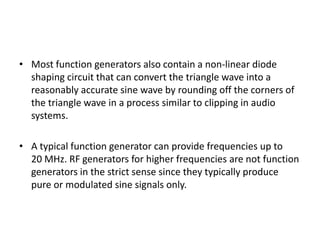Function generator
- 1. FUNCTION GENERATOR Prepared By: Submitted To: Himanshu Sapra Pooja Prajesh
- 2. Function Generator • A FUNCTION GENERATOR is usually a piece of electronic test equipment or software used to generate different types of electrical waveforms over a wide range of frequencies. • Some of the most common waveforms produced by the function generator are the sine, square, triangular and sawtooth shapes. • These waveforms can be either repetitive or single-shot. which requires an internal or external trigger source.
- 3. • Integrated circuits used to generate waveforms may also be described as function generator Ics. • Other important features of the function generator are continuous tuning over wide bands with max-min frequency ratios of 10:1 or more, a wide range of frequencies from a few Hz to a few MHz, a flat output amplitude and modulation capabilities like frequency sweeping. frequency modulation and amplitude modulation.
- 5. Working • Simple function generators usually generate triangular waveform whose frequency can be controlled smoothly as well as in steps. • This triangular wave is used as the basis for all of its other outputs. • The triangular wave is generated by repeatedly charging and discharging a capacitor from a constant current source. This produces a linearly ascending or descending voltage ramp.
- 6. • As the output voltage reaches upper and lower limits, the charging and discharging is reversed using a comparator, producing the linear triangle wave. • By varying the current and the size of the capacitor, different frequencies may be obtained. • A 50% duty cycle square wave is easily obtained by noting whether the capacitor is being charged or discharged, which is reflected in the current switching comparator output.
- 7. • Most function generators also contain a non-linear diode shaping circuit that can convert the triangle wave into a reasonably accurate sine wave by rounding off the corners of the triangle wave in a process similar to clipping in audio systems. • A typical function generator can provide frequencies up to 20 MHz. RF generators for higher frequencies are not function generators in the strict sense since they typically produce pure or modulated sine signals only.
- 8. • Function generators, like most signal generators, may also contain an attenuator, various means of modulating the output waveform, and often the ability to automatically and repetitively "sweep" the frequency of the output waveform (by means of a voltage-controlled oscillator) between two operator-determined limits. • This capability makes it very easy to evaluate the frequency response of a given electronic circuit.
- 9. • Some function generators can also generate white or pink noise. • More advanced function generators are called arbitrary waveform generators (AWG). • They use direct digital synthesis (DDS) techniques to generate any waveform that can be described by a table of amplitudes.
- 11. Direct Digital Synthesis (DDS) • Direct digital synthesis (DDS) is a method of producing an analog waveform—usually a sine wave—by generating a time-varying signal in digital form and then performing a digital-to-analog conversion. • Because operations within a DDS device are primarily digital, it can offer fast switching between output frequencies, fine frequency resolution, and operation over a broad spectrum of frequencies. • With advances in design and process technology, today’s DDS devices are very compact and draw little power.
- 12. Figure - Square-, triangular-, and sinusoidal outputs from a DDS.
- 13. Specifications Typical specifications for a general-purpose function generator are as below. • Produces sine, square, triangular, sawtooth (ramp), and pulse output. Arbitrary waveform generators can produce waves of any shape. • It can generate a wide range of frequencies. For example, the Tektronix FG 502 (ca 1974) covers 0.1 Hz to 11 MHz.
- 14. • Frequency stability of 0.1 percent per hour for analog generators or 500ppm for a digital generator. • Maximum sinewave distortion of about 1% (accuracy of diode shaping network) for analog generators. Arbitrary waveform generators may have distortion less than -55dB below 50 kHz and less than -40dB above 50 kHz. • Some function generators can be phase locked to an external signal source, which may be a frequency reference or another function generator.
- 15. • AM or FM modulation may be supported. • Output amplitude up to 10V peak-to-peak. • Amplitude can be modified, usually by a calibrated attenuator with decade steps and continuous adjustment within each decade. • Some generators provide a DC offset voltage, e.g. adjustable between -5V to +5V.
- 16. Software • A completely different approach to function generation is to use software instructions to generate a waveform, with provision for output. • For example, a general-purpose digital computer can be used to generate the waveform; if frequency range and amplitude are acceptable, the sound card fitted to most computers can be used to output the generated wave.
- 17. Circuit elements • An electronic circuit element used for generating waveforms within other apparatus is also described as a function generator, or waveform generator. • A sub-system may provide an output proportional to some mathematical function of its input. • For example, the output may be proportional to the square root of the input. • Such devices are used in feedback control systems and in analog computers.
- 18. References • www.google.com • www. Function generator - Wikipedia, the free encyclopedia.htm
- 19. THANK YOU



















